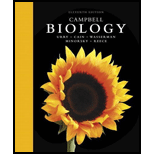
Lacking tissues and organs, how do soonges accomplish tasks such as gas exchange, nutrient transport, and waste disposa I?
To determine: How sponges perform “gas exchange, nutrient transport, and waste disposal” without tissues and organs.
Introduction: All sponges belong to the phylum Porifera. They are the simplest animals with the cellular level of organization. They have diverged forms than other animals early in evolution. Most of the body parts of sponges are asymmetrical. Sponges consist of pores in their body called ostia.
Explanation of Solution
The sponges have a relatively simple body plan with all cells of the body in direct contact with water. This allows excretion and exchange of gases to occur through diffusion. The sponges are filter feeders and contain choanocytes (collar cells) that help them to get food. The beating of flagella of choanocyte draws food particles along with water. The food particles stick to collar-like projections of the choanocytes. The food particles are then phagocytized and are either digested or passed on to the other cells called amoebocytes. These amoebocyte cells then transfer it to other cells of the body.
Want to see more full solutions like this?
Chapter 33 Solutions
Campbell Biology (11th Edition)
- Noggin mutation: The mouse, one of the phenotypic consequences of Noggin mutationis mispatterning of the spinal cord, in the posterior region of the mouse embryo, suchthat in the hindlimb region the more ventral fates are lost, and the dorsal Pax3 domain isexpanded. (this experiment is not in the lectures).a. Hypothesis for why: What would be your hypothesis for why the ventral fatesare lost and dorsal fates expanded? Include in your answer the words notochord,BMP, SHH and either (or both of) surface ectoderm or lateral plate mesodermarrow_forwardNot part of a graded assignment, from a past midtermarrow_forwardNot part of a graded assignment, from a past midtermarrow_forward
- please helparrow_forwardWhat does the heavy dark line along collecting duct tell us about water reabsorption in this individual at this time? What does the heavy dark line along collecting duct tell us about ADH secretion in this individual at this time?arrow_forwardBiology grade 10 study guidearrow_forward
 Biology 2eBiologyISBN:9781947172517Author:Matthew Douglas, Jung Choi, Mary Ann ClarkPublisher:OpenStax
Biology 2eBiologyISBN:9781947172517Author:Matthew Douglas, Jung Choi, Mary Ann ClarkPublisher:OpenStax Biology: The Dynamic Science (MindTap Course List)BiologyISBN:9781305389892Author:Peter J. Russell, Paul E. Hertz, Beverly McMillanPublisher:Cengage Learning
Biology: The Dynamic Science (MindTap Course List)BiologyISBN:9781305389892Author:Peter J. Russell, Paul E. Hertz, Beverly McMillanPublisher:Cengage Learning Concepts of BiologyBiologyISBN:9781938168116Author:Samantha Fowler, Rebecca Roush, James WisePublisher:OpenStax College
Concepts of BiologyBiologyISBN:9781938168116Author:Samantha Fowler, Rebecca Roush, James WisePublisher:OpenStax College





